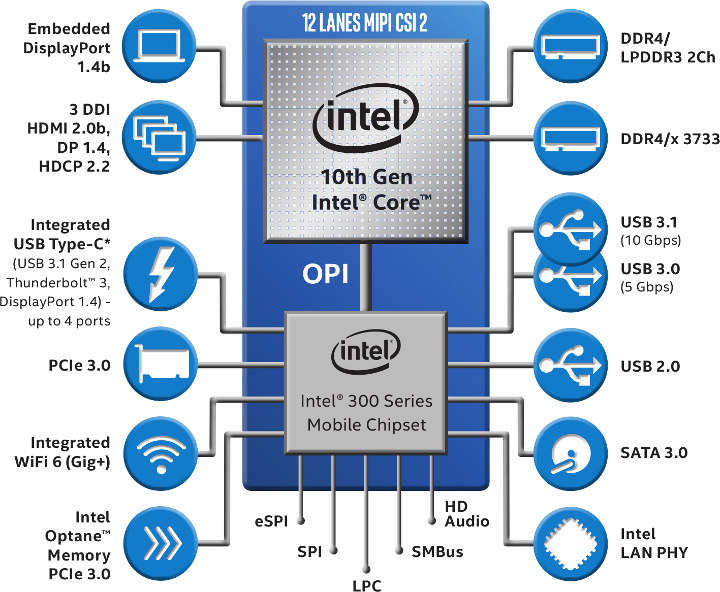Intel has provided a few more details about their upcoming Intel Ice Lake Y-Series processor that will succeed their Amber Lake Y-Series family comprised of Core m, and Core i5/i7 processors with 5W to 7W TDP.
Ice Lake Y-Series processor will come with the latest Intel Gen11 graphics with up to 64 EU (Execution Units), have a higher 9W TDP, configurable up to 12 Watts, and be manufactured with Intel’s 10nm process.
Highlights of Intel Ice Lake Y-Series processors:
- CPU – 10nm+ quad-core processor, 14nm Platform Controller Hub (PCH )
- GPU – Gen 11 Intel Graphics Engine, up to 64 EUs; Open GL 4.5, DirectX 12, and OpenCL 2.2 API support
- AI – Intel GNA (Gaussian Network Accelerator)
- Memory I/F – LPDDR4/x-3733
- Camera – IPU4p: 16MP, 4K30, 4x cameras, RGB+IR camera
- Video Output
- eDP 1.4b up to 4K120/5K60 (10-bit) resolution
- DisplayPort 1.4 up to 4K120/5K60 (10-bit) resolution
- HDMI 2.0b up to 4K60 (10-bit) resolution; HDCP 2.2 support
- HDR110 hardware support
- Video
- Decode – 2x 4k60 8-bit 4:2:0 AVC/VP8; 4K60 10-bit 4:2:2/4:4:4 HEVC/VP9; 8K30 10-bit 4:2:0 HEVC/VP9
- Encode – 2x 4K60 8-bit 4:2:0 AVC; 4K60 10-bit 4:4:4 HEVC/VP9; 8K30 10-bit 4:2:0 HEVC/VP9
- Wireless Connectivity
- Integrated WiFi + Bluetooth (CNVi AC / WiFi 6 support)
- XMM7360 or XMM7560 M.2 modem for cellular connectivity
- USB – USB type-C port with support for USB 3.1 Gen 2, Thunderbolt 3, DisplayPort 1.4
- Security – SGX 2.0 with ecosystem scaling
The Intel Core i3/i5/i7 SoCs will be equipped with up to 4 “Sunny Cove” cores and 8 threads, a PCH with up to two SATA interfaces, eMMC 5.1 and SDXC 3.0 storage interfaces, 5x PCIe Gen 3 interfaces across 14 lanes, 6x USB 3.0 interfaces, and more. Intel announced Ice Lake Y-Series processor together with the more powerful 15W Ice Lake U-Series processors. You’ll find more details for both 10th generation processor families in the product brief.
The good news is that the 10nm Intel Ice Lake processors are now shipping, and should be found in laptops and 2-in-1 hybrids by the end of this year.
Via Liliputing

Jean-Luc started CNX Software in 2010 as a part-time endeavor, before quitting his job as a software engineering manager, and starting to write daily news, and reviews full time later in 2011.
Support CNX Software! Donate via cryptocurrencies, become a Patron on Patreon, or purchase goods on Amazon or Aliexpress






A gut feeling is telling me apple might not be impressed.
Knowing how Apple specs their kit they’ll probably love something like this:
“You mean we can have the whole system in a single chip no one has a hope in hell of upgrading or repairing?? We’ll pay more if you can integrate all of the memory and local storage into it too”.
I guess you are aware that Apple already uses a capable ARM companion on their current line-up making the real difference? The T2’s job is ‘audio input processing (for Hey Siri), image signal processing (for the FaceTime camera), hardware video encoding, secure boot, a secure enclave for Touch ID, system management controller functionality, and serves as a (impressively high performance) SSD controller’
>hardware video encoding,
I can do that on my 1080TI I bought with the $2k or more I saved from not buying a mac with lesser specs. 😀
>secure boot, a secure enclave for Touch ID, system management controller functionality,
I’m sure apple have made great claims about this meaning “innovation” or something but it’s pretty obvious it’s further vendor lock in and a further attempt to stop OSX running on cheaper superior hardware.
>and serves as a (impressively high performance) SSD controller’
Does that make up for only being able to have 16GB of RAM without having to sell a kidney?
pcie3 and two sata… AMD it is then.
> pcie3
What’s wrong with this? You want PCIe 4 in a mobile device today? AMD’s X470 chipset has a 5 W TDP while PCIe 4 capable X570 shows a whopping 11W…
> You want PCIe 4 in a mobile device today?
I wanted it two years ago. The vertigo inducing latency issues in VR/AR largely stem from the memory bandwidth. Put mobile cores on the market with PCIe4/5 and you’ll have mobile low-power discrete graphics running circles around anything you can find in a SoC.
I want 4 sata 3, 1 nvme x4, 1 pcie 3 x8 slot, ddr4 3200 dual or quad, don’t care about graphics, 8-core CPU. The x8 slot for a ConnectX-3.
Even just a bumped Odroid HC2 with an AMD V1605B would do. I would buy several of them, as long as it has an x8 slot and an nvme x4 to cache the two sata…
You know that Y series is for ultrabook/tablet ?
Encode – 2x 4K60 8-bit 4:2:0 AVC; 4K60 10-bit 4:4:4 HEVC/VP9; 8K30 10-bit 4:2:0 HEVC/VP9
really? 4K60 10bit 4:4:4 hevc without dedicated gpu? we’re talking about a 9W intel chip.
i expect this encoding power in Xeon E series…
There’s dedicated Gen11 graphics inside the chip. They had to increase TDP from 5-7W for Amber Lake-Y to 9W for Ice Lake-Y maybe that’s why.
It’s the classical ‘work smarter not harder’ approach and Intel calls this QuickSync (do the encoding on the video engine and not the CPU cores).